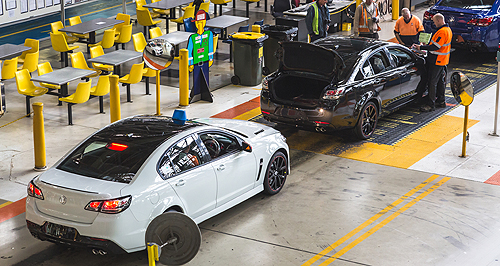News - HoldenHolden exit: Last Commodores ‘the best’Bittersweet: The quality levels at Holden’s Elizabeth assembly plant – which closes this Friday – are higher than any other GM factory in the world this year, with Holden manufacturing director Martin Merry (left) overseeing the operation. Elizabeth tops GM plants for quality as Holden goes out with head held high14 Oct 2017 HOLDEN’S Elizabeth car factory is set to go out on top this week, recording the highest quality results of any current General Motors plant, even in its death throes. The final locally made Commodores rolling from the plant on Adelaide’s northern fringe in the past month have notched a “right-first-time” rate above 98 per cent – the best ever for Holden and better than levels achieved at any other GM plant this year. This means that less than two per cent of the 175 cars a day currently produced at Elizabeth need any form of rectification at the end of the production line – high by any global standard. Toyota’s Altona plant, which closed earlier this month, also recorded its best-ever quality levels as it headed towards the end. Holden’s Elizabeth factory will close this Friday, bringing to an end 161 years of Holden manufacturing in Australia, including almost 80 years of “Australia’s own car”. Only French company Peugeot, which started as a bicycle and coffee machine manufacturer in 1810, can claim a longer history among world automotive brands. Founded as a saddlery in Adelaide in 1856 by James Holden, the Australian company graduated to carriages and then built its first car body in 1917. Because Holden was building bodies for many General Motors models, including Buicks, Chevrolets and Vauxhalls, GM bought the company during the Great Depression, in 1931, and in league with local executives drove the development of the first all-Australian car, the 48-215, in 1948. In 1964, employment peaked at 23,914, with Holden operating assembly plants around the country, in South Australia, Victoria and New South Wales. Elizabeth, which opened in 1959 in a burst of post-WWII enthusiasm milked by then SA premier Sir Thomas Playford, will be the last of those to close, a victim of 21st century cost pressures, overseas competition and the decline of the traditional Aussie large car that once held the lion’s share of the market. Ironically, efficiency and quality of Holden’s manufacturing operations have never been better. Even exchange rates that peaked at a crippling 110 cents to the American dollar and cruelled exports around the time GM pulled the pin are back at a manageable 80 cents. Although 800 workers have already left the Elizabeth plant since the closure announcement, mostly due to the axing of Cruze small car production last year, a further 945 will walk through the gates for the last time this week. According to senior Holden executives, the company feared that after the decision to close Australian manufacturing operations was announced in 2013, quality would drop off as workers became disillusioned and started looking for new employment. Instead, quality has improved steadily, rising from 64 per cent right-first-time with the introduction of the VF Commodore to above 98 per cent in August. Holden manufacturing director Martin Merry, who will be looking for a new job in his home town of Melbourne once he oversees the decommissioning of the Elizabeth plant, said manufacturing managers have had to keep on raising quality targets over the past few years as each level was eclipsed. He said that rather than losing morale, the workers had lifted to the task. “Just this morning, we scored the best paint score ever on a car built here,” he told GoAuto when we visited the factory for a last look recently. “The way the workers have responded has been amazing.” Like many workers at the plant, Mr Merry has ordered a new car – a V8-powered Holden Commodore Motorsport special edition – as a memento of his 32 years in Holden manufacturing that started at the Holden four-cylinder engine plant in Victoria. Body shop manager Paul Sakovits, a 23-year veteran of the Elizabeth plant, said he had loved every moment of his career there. He praised Holden’s commitment to the transition of workers from the factory to new jobs, saying the Transition Centre established in administration offices at Elizabeth and other initiatives such as jobs fairs had given workers confidence that they would be okay in life after Holden. Mr Sakovits said this had helped the production line workers maintain their focus. “It is getting close now (the closure), but it is time to savour what we have done,” he said. “We want to go out with our heads held high.” Mr Sakovits said that partly because of the level of worker pride in the plant and its products and partly because a proportion of the cars coming down the line had been bought by workers, each car was being “built like it is their own”. He said the skills learned by Holden workers would now help other industries. Asked if he thought he the Australian community knew what it was losing with the demise of Holden manufacturing, he said: “I don’t think they do.”  Read more14th of October 2017  Holden exit: Tracing 161 years of mobilityAustralia’s own car-maker fades to black after 16 decades of Holden manufacturing14th of October 2017  Holden exit: Lion brand to honour its heritageHeritage centre – or two – proposed to house Holden’s historic car collection31st of August 2017  Time running out for Holden machinery bidsGoing, going … bidding for Holden Elizabeth factory equipment closes in October |
Click to shareHolden articlesResearch Holden Motor industry news |




































































Facebook Twitter Instagram